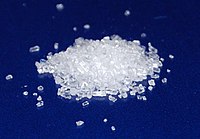Zinc sulfate
 |
|
 |
|
| Names | |
|---|---|
|
IUPAC name
Zinc sulfate
|
|
| Other names
White vitriol
Goslarite |
|
| Identifiers | |
|
7733-02-0 7446-19-7 (monohydrate) 13986-24-8 (hexahydrate) 7446-20-0 (heptahydrate) |
|
| 3D model (Jmol) | Interactive image |
| ChEBI |
CHEBI:35176 |
| ChEMBL |
ChEMBL1200929 |
| ChemSpider |
22833 |
| ECHA InfoCard | 100.028.904 |
| EC Number | 231-793-3 |
| PubChem | 24424 |
| RTECS number | ZH5260000 |
| UNII |
0J6Z13X3WO |
| UN number | 3077 |
|
|
|
|
| Properties | |
| ZnSO4 | |
| Molar mass | 161.47 g/mol (anhydrous) 179.47 g/mol (monohydrate) 287.53 g/mol (heptahydrate) |
| Appearance | white powder |
| Odor | odorless |
| Density | 3.54 g/cm3 (anhydrous) 2.072 g/cm3 (hexahydrate) |
| Melting point | 680 °C (1,256 °F; 953 K) decomposes (anhydrous) 100 °C (heptahydrate) 70 °C, decomposes (hexahydrate) |
| Boiling point | 740 °C (1,360 °F; 1,010 K) (anhydrous) 280 °C, decomposes (heptahydrate) |
| 57.7 g/100 mL, anhydrous (20 °C) (In aqueous solutions with a pH < 5) | |
| Solubility | alcohols |
| −45.0·10−6 cm3/mol | |
|
Refractive index (nD)
|
1.658 (anhydrous), 1.4357 (heptahydrate) |
| Thermochemistry | |
|
Std molar
entropy (S |
120 J·mol−1·K−1 |
|
Std enthalpy of
formation (ΔfH |
−983 kJ·mol−1 |
| Pharmacology | |
| A12CB01 (WHO) | |
| Hazards | |
| Safety data sheet | ICSC 1698 |
|
EU classification (DSD)
|
Harmful (Xn) Dangerous for the environment (N) |
| R-phrases | R22, R41, R50/53 |
| S-phrases | (S2), S22, S26, S39, S46, S60, S61 |
| Flash point | Non-flammable |
| Related compounds | |
|
Other cations
|
Cadmium sulfate Manganese sulfate |
|
Related compounds
|
Copper(II) sulfate |
|
Except where otherwise noted, data are given for materials in their standard state (at 25 °C [77 °F], 100 kPa).
|
|
|
|
|
| Infobox references | |
Zinc sulfate is an inorganic compound and dietary supplement. As a supplement it is used to treat zinc deficiency and to prevention the conditions in those at high risk. Side effects may include abdominal pain, vomiting, headache, and feeling tired.
It has the formula ZnSO4 as well as any of three hydrates. It was historically known as "white vitriol". All of the various forms are colourless solids. The heptahydrate is commonly encountered.
In medicine it is used together with oral rehydration therapy (ORT) and an astringent.
The hydrates, especially the heptahydrate, are the primary forms used commercially. The main application is as a coagulant in the production of rayon. It is also a precursor to the pigment lithopone.
It is used as in electrolytes for zinc plating, as a mordant in dyeing, as a preservative for skins and leather.
Zinc sulfate is used to supply zinc in animal feeds, fertilizers, toothpaste, and agricultural sprays. Zinc sulfate, like many zinc compounds, can be used to control moss growth on roofs.
Zinc sulfate powder is an eye irritant. Ingestion of trace amounts is considered safe, and zinc sulfate is added to animal feed as a source of essential zinc, at rates of up to several hundred milligrams per kilogram of feed. Excess ingestion results in acute stomach distress, with nausea and vomiting appearing at 2-8 mg/Kg of body weight.
Zinc sulfate is produced by treating virtually any zinc containing material (metal, minerals, oxides) with sulfuric acid.
Specific reactions the reaction of the metal with aqueous sulfuric acid:
Pharmaceutical grade zinc sulfate is produced by treating high purity zinc oxide with sulfuric acid:
...
Wikipedia
